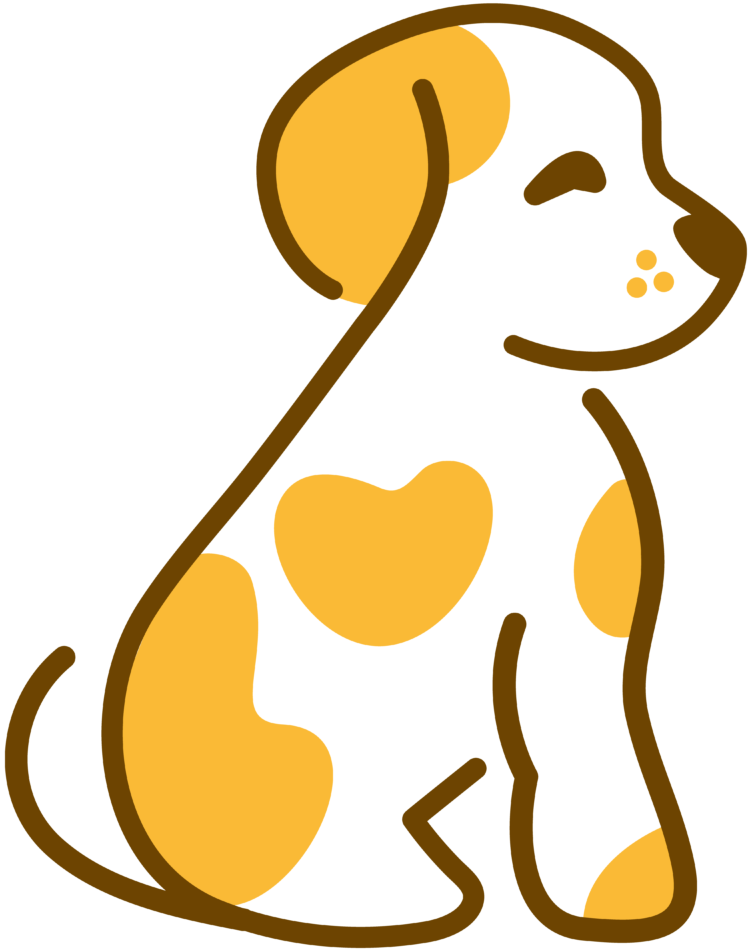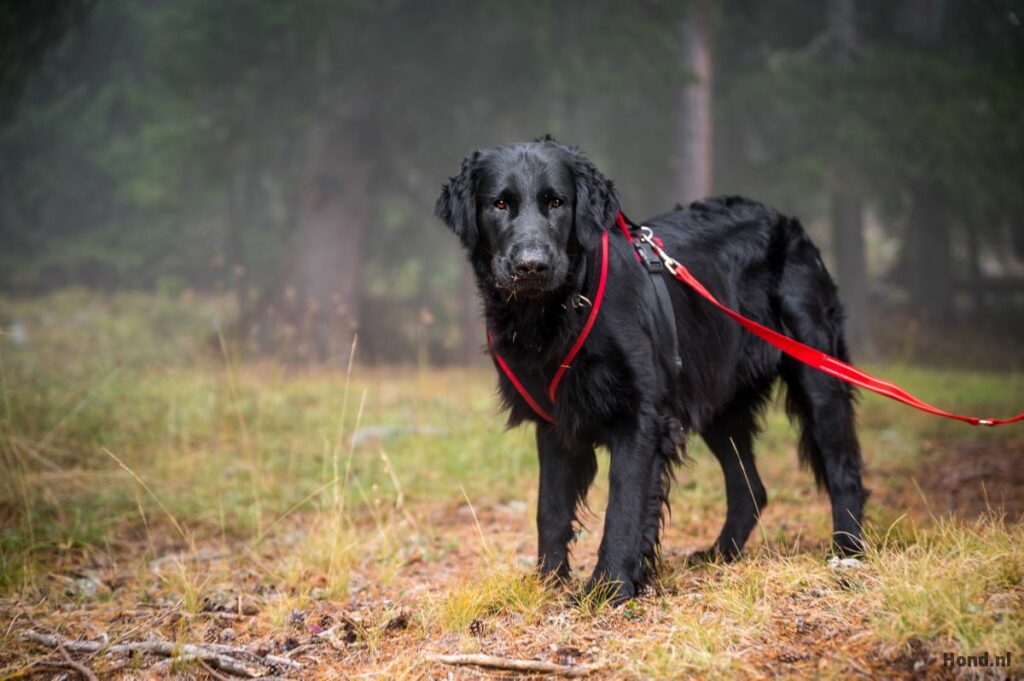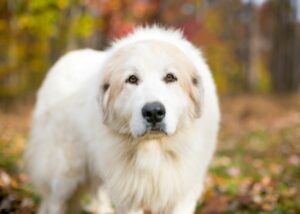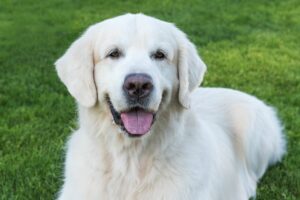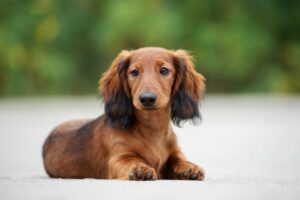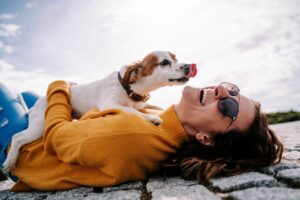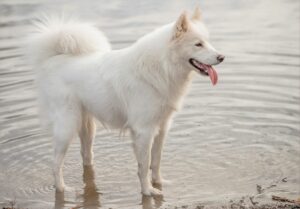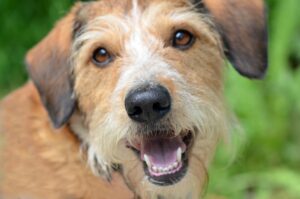The Flat-Coated Retriever was the most popular Retriever in England in the nineteenth century. He was formerly used as a hunting dog, but is nowadays also common in the US. It is a cheerful, intelligent dog that fits well in a family with children. This dog breed gets along well with children and is friendly and affectionate towards its owner.
A Flat-Coated Retriever is energetic and needs a lot of exercise. It is important that he has a owner who undertakes activities with him. Are you curious and do you want to know more about the Flat-Coated Retriever? Then read this article.
The history: an English hunting dog
The Flat-Coated Retriever is one of the six Retriever breeds. This dog breed was bred by the English to assist in hunting and to retrieve shot game. These dogs were able to see where a duck was falling down and swam to it on command. Then they gently grabbed the duck in their mouths without damaging it and brought it to their owner.
The Flat-Coated Retriever was first bred in the 19th century and was the most popular Retriever in England. This dog breed was bred by crossing the Newfoundland and the Sheepdog. The Newfoundland can swim well and a Sheepdog is lightly built. So the Flat-Coated Retriever is a combination of these two; a dog that is lightly built and can swim well. These qualities make it a suitable hunting dog. In 1915, the AKC recognized the Flat-Coated Retriever.
Around World War II, it seemed that this breed would disappear. It became less and less popular, so the Flat-Coated Retriever was threatened with extinction. Fortunately, breeders managed to bring the breed back. Nowadays, the breed is fairly popular and serves mainly as a companion dog and show dog.
The character: energetic, friendly and cheerful
A Flat-Coated Retriever is a playful dog that loves to engage in activities with its owner. This dog breed has a lot of energy and needs a lot of exercise. They are cheerful, friendly and towards their owner they are very affectionate. They love to be petted and to get attention. Therefore, they do not like to be alone. A Flat-Coated Retriever fits well in a family with children. He likes to play with children, but can sometimes be a bit intrusive. Therefore, you should socialize the dog well and never leave him alone with young children.
A Flat-Coated Retriever can be independent and stubborn. He likes to think for himself. If he exhibits this behavior, you must be kind and consistent. A young Flat-Coated Retriever can be a bit wild, this requires quite some patience and clear guidance. This dog breed is not mentally mature until three years of age. You will read later in this article how to train a Flat-Coated Retriever best.
Towards strangers, a Flat-Coated Retriever is friendly. He is not suitable as a watchdog. With other dogs and pets he can generally cope well, although you must first give the animals time to get used to each other.
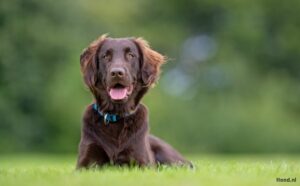
The appearance of a Flat-Coated Retriever
A Flat-Coated Retriever is a medium-sized dog that exudes elegance and speed. A male dog weighs an average of 30 pounds with a height at the withers between 58 and 61 centimeters. A female weighs an average of 27 pounds with a height at the withers between 55 and 58 centimeters.
His head is long with a flat skull. The chest is quite deep and broad. The legs of a Flat-Coated Retriever are straight and muscular. The nose is quite large and the nostrils are wide. The ears are small and hang down against the head. The eyes are set far apart and are brown in color. A Flat-Coated Retriever looks friendly and has a cheerful expression. The tail is carried horizontally. Usually the tail does not rise above the back.
The coat of a Flat-Coated Retriever is of medium length. The hairs are close together and are shiny. The ideal coat is straight and flat. The hairs can be wavy and are often black or brown in color. The hairs at the tail, back of the legs, neck and chest are often a bit longer.
The care
The coat of a Flat-Coated Retriever should be brushed regularly to remove dirt and loose hair. This should be done at least once a week. A Flat-Coated Retriever sheds twice a year. During these periods, it is wise to brush more often to keep the dog looking well groomed. The coat repels water and dirt, so it is not necessary to bathe the dog. You can consider this when the Flat-Coated Retriever is covered in mud or has swum in the ditch.
Besides the care of the coat, it is important to keep the ears clean. This can be done with a clean damp cloth. Also, the nails regularly checked and trimmed if necessary.
Care that your dog gets the right food and on a correct weight remains. It is important that a dog does not become too heavy, because that is not good for its joints. You can always ask the veterinarian for advice on what kind of food is suitable for your dog.
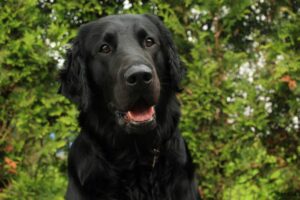
Are there any diseases that occur in this breed?
A Flat-Coated Retriever lives to be 8 to 14 years old. Unfortunately, there are hereditary disorders and diseases that occur regularly in this dog breed. The most common disorders in a Flat-Coated Retriever are:
- Dilated cardiomyopathy
- Hip and elbow dysplasia
- Eye disorders
- Cancer and tumors
Dilating cardiomyopathy is a condition of the heart in which the heart muscle is unable to contract with sufficient force. The cause of this is not known. Symptoms include shortness of breath and decreased endurance.
Hip and elbow dysplasia are also common in Flat-Coated Retrievers. In this disorder, the joint head does not fall properly into the socket of the joint. This can get worse later in life, causing the dog to suffer from lameness and joint wear. This dog breed can also suffer from various eye disorders. This reduces vision and they can even become completely blind.
In a Flat-Coated Retriever, many types of cancer and tumors occur. It is therefore important to always remain alert if you discover a lump or other abnormalities on the body. If in doubt, you can always contact your veterinarian. It can be benign or malignant.
Did you know?
In addition to the Flat-Coated Retriever, there are five other Retriever breeds. Retriever dogs are very popular in the US. They are ideal family dogs because of their positive characteristics. The other five Retriever breeds are:
- Golden Retriever
- Labrador Retriever
- Curly coated Retriever
- Nova Scotia duckling Retriever
- Chesapeake Bay Retriever
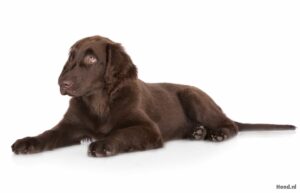
Dog training for this breed
A Flat-Coated Retriever is easy to train and loves to exercise. He is smart and learns quickly, but the pitfall is that he can get bored and distracted quickly. Therefore, you must make sure that the training is varied. In raising and training it is important that you remain calm and consistent, this allows you to keep the puppy’s busy behavior under control. Reward good behavior as much as possible and try to prevent unwanted behavior.
For every puppy a basic training is important to do. During a puppy course the puppy learns to follow instructions and he will build a bond with his owner faster. A follow-up course is also recommended for a Flat-Coated Retriever. This is recommended to be able to control the puberty.
How much does a Flat-Coated Retriever cost?
A Flat-Coated Retriever puppy with a pedigree costs on average $1200. If you want an adult Flat-Coated Retriever, you can often go to a shelter or a breed club. When you buy a puppy, you have to make sure that you buy it from a certified breeder. An authorized breeder is aware of any hereditary disorders and diseases in the pedigree. Also, recognized breeders often have the best interest with the puppy and the mother dog.
In addition to the purchase, you must take into account costs that recur monthly and/or annually. On average, you will spend $45 per month on food for a Flat-Coated Retriever. In addition, you have to take into account vet fees, dog tax, costs for care and toys, among other things.
How much exercise does this breed need?
The Flat-Coated Retriever has a lot of energy, so it is important that he gets the opportunity to use his energy every day. A Flat-Coated Retriever should be walked at least two hours a day. In addition, activities such as running, swimming and walking alongside the bike are also good activities to give the dog enough exercise. If you have a fenced yard, you can also let your Flat-Coated Retriever play outside independently.
In addition to exercise, the Flat-Coated Retriever loves to play games. In the past, this dog breed was used as a hunting dog and retrieving was its job. Nowadays, they therefore still like to do fetch games with their owner. Other games and tasks where they have to use their brains are also important. They are intelligent dogs that need to be mentally stimulated to prevent boredom.
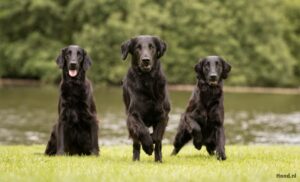
Recognition in The Netherlands
The AKC recognized the Flat-Coated Retriever in 1915. Also, breed associations for this breed exist in the US. These breed clubs are concerned with the development of the breed in terms of health, behavior and work. A well-known association that is affiliated with the AKC is the Flat-Coated Retriever Society of America. For more information about this breed club you can visit their website.
Do you already own a Flat-Coated Retriever or are you planning on getting one?
A Flat-Coated Retriever is one of the six Retriever breeds and is popular in the US. If you are looking for a happy family dog, then a Flat-Coated Retriever might be right for you. He gets along well with children and enjoys undertaking activities with his owner. Because he used to be used as a hunting dog, he loves retrieving games. Do you already own a Flat-Coated Retriever or are you planning to purchase one? Leave a comment to share your experiences.
